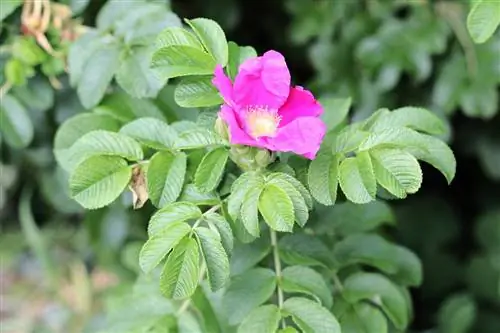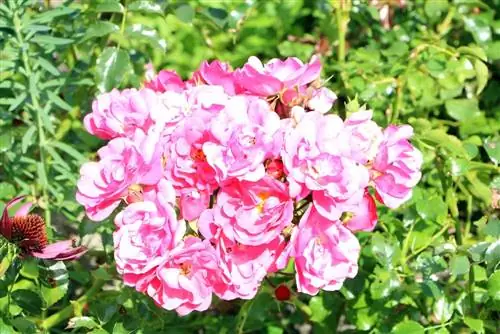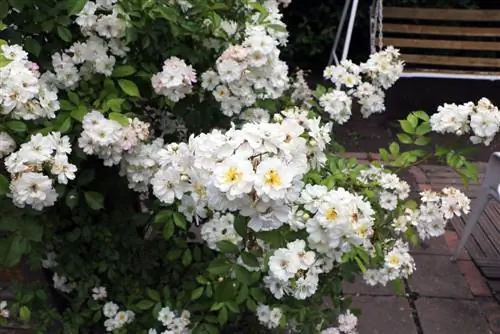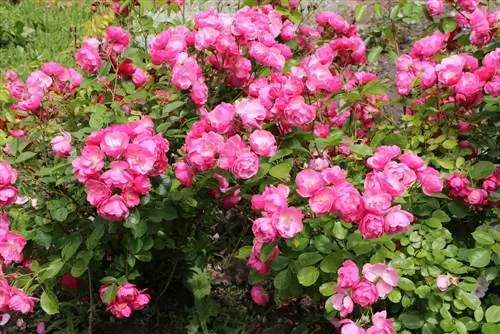- Author admin [email protected].
- Public 2023-12-17 03:39.
- Last modified 2025-01-24 12:45.
Scented roses - varieties, care and cutting The rose is undisputedly considered the queen of the garden. Hardly any other flower can compete with the magnificently blooming rose. Old and traditional but also new varieties enrich every garden. If the rose has a particularly intense scent in addition to its enchanting and bright flowers, it is called a scented rose.
Scented roses are available in numerous colors and place high demands on location and care.
Enchanting scent with different varieties
The scented rose earns its name because of its particularly intense scent and is found in many types of roses. Shrub roses, noble roses, climbing roses, bed roses or wild roses not only require different care requirements, but also each have an unmistakable scent. Known varieties are:
- Damask Rose
- Charles Austin
- Muscosa
- Michelangelo
- White Rose
- Bourbon rose
- Spring Gold
- Othello
- Spring Gold
- French Rose
- Scent Rush
- Scent Cloud
- Westerland
- Scented Gold
The right location for scented roses
The rose, including the scented rose, places high demands on its location. In order to enjoy the splendor of the flowers and the intense scent as much as possible and to protect the rose from pest infestation, you should pay attention to the following aspects:
- choosing a sunny to partially shaded location
- Avoid blazing midday sun, a southwest or southeast location is optimal
- Moisture should be able to dry off quickly through wind and sun to prevent fungal infestation
- avoid close planting
- Refertilizing the soil is essential if roses were already growing at the chosen location
- Roses are deep-rooted, sandy and humus-rich soils are preferred
- Avoid planting under trees, otherwise there is a risk of moisture damage
Planting fragrant roses correctly
The optimal planting time is autumn. This gives the rose the opportunity to root into the ground earlier than if it were planted in spring. Planting roses in autumn has the advantage that they can use the spring to grow and thus thrive and bloom more quickly. There are also important aspects to consider when planting.
- water both bare root roses and roses with soil balls before planting
- When watering, the root ball should be covered with water up to the thickening (grafting point)
- shorten the shoots of the root to approx. 20 cm
- remove damaged roots, leave the small and fine roots untouched
- Only prune the roots of roses with bales if they are damaged
- Dig out the planting hole depending on the root length and a diameter of approx. 50 cm
- The grafting point of the scented rose should be approximately 5 cm below the ground
- When closing the planting hole, enrich the soil with fertilizer, chips or humus
- tread the floor after closing it
- water well after planting
- cover the seedling with soil at a height of 15 cm to protect it from frost
Care for scented roses
Once you have found the optimal location for the scented rose, the following care tips should be taken into account over the course of the gardening year.
- Watering is only necessary when it is dry, as the rose is a deep-rooted plant that supplies itself from the lower layers of the soil
- Watering should be done in the early morning hours so that the rose has the opportunity to dry out
- If there is too much and frequent moisture, there is a risk of mildew and fungal infestation
- Fertilizing with complete fertilizer is recommended from the second year onwards
- The fertilizer time for optimal utilization is spring
- Potassium fertilizer promotes the woodiness of rose shoots
- pesticides can be sprayed against various rose diseases
- After winter rest, remove dead shoots with rose scissors
- loose the soil around the rose in spring
- remove sick leaves to avoid further infestation of the rose
- cut off faded heads
- Remove wild shoots over the course of the summer (often recognizable by small, seven-feathered leaves)
- continuously check the scented rose for pests and treat if necessary
- remove leaves around the roses in autumn to prevent moisture damage, among other things
- cut the scented rose back to approx. 25 cm before the first frost
- remove flowers, buds and leaves before overwintering
Overwintering scented roses
If the scented rose is cut back before the first frost sets in, it must be covered with soil, humus, pine branches, brushwood or other suitable material for overwintering. Otherwise the plant is at risk of severe frost damage.
Diseases and pests
Like all flowers, the scented rose is not safe from the threat of pest infestation. While rose diseases can be prevented through proper care, pests often have to be combated intensively.
Aphids
The animals cause the plant to wither. In spring, the shoots of the rose should be examined for the black eggs of the pests. Cut off affected shoots and dispose of them. Treatment depends on the severity of the infestation. If there are a few animals, you can try rinsing them off with water; if the infestation is more severe, you can use soft soap or commercially available products.
Spider mites
Are recognizable by their fine web and grayish color. The formation of spider mites can be avoided by choosing the right location and by watering adequately during prolonged drought. If the entire plant is infested, only cutting back helps, otherwise the spider mite can be controlled with commercially available products.
Fungal infestation
Recognizable by black spots on the leaves, subsequent yellowing and leaf drop. Fungal infestation inhibits growth and flower formation, while cool and damp weather promotes infestation. Remove diseased and fallen leaves from the bed.
Mildew
Typical characteristic: white coating that can be wiped off. Mildew is favored by large temperature fluctuations and affects the he althy growth of the plant. Cut out affected shoots and possibly treat the scented rose with commercially available products. If fungal infestation and mildew recur every year, you should consider purchasing resistant plants.
With its demands on care and choice of location, the scented rose is certainly not a frugal plant. If you want to enjoy the scent and the indescribably beautiful flowers year after year, you should be prepared to invest time in caring for this plant. You will definitely be rewarded with enchanting beauty.
What you should know about scented roses in brief
There are many different types of roses: noble roses, wild roses, shrub or climbing roses, floribunda roses and many more. However, varieties that exude an intoxicating scent in addition to their beauty are particularly popular.
- Today we are trying to combine the charm of the old historical varieties with the blooming joy of modern roses. There are many fragrant varieties, especially when it comes to shrub roses and climbing roses
- Fragrant roses are a delight for the senses. The smell is in the petals. It varies and depends on temperature, sunlight, season and other factors.
- Scented roses are also used to make perfume. This requires an incredible number of flowers. But rose jellies, rose liqueur, rose sugar, rose teas and rose vinegar are also very well known and popular.
- It is particularly important that only unsprayed roses are used!
Scent is the most sensual quality of roses. Unfortunately, not all roses are fragrant anymore. The flower lover somehow automatically bends down to smell a beautiful rose petal. Moss roses smell very good, they have a balsamic-tart undertone. Many English roses and new romantic and nostalgic roses have been bred to have their scent again. Fragrance notes have often shifted from floral to fruity. Some noble roses retain the intense scent of tea roses. A scented rose can often be identified by its name, e.g. Scent Magic, Scent Rush, Scent Gold, Scent Vestival.
It is important to place the nose charms in the garden so that you can notice their smell. A good place is near the seat, i.e. on the terrace or on the balcony. Garden areas that are often passed by are also ideal, i.e. near the entrance door, on the main path, or by the carport. Scented roses are an experience.






